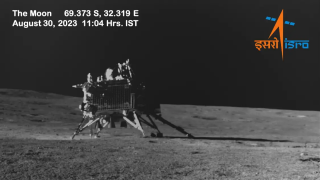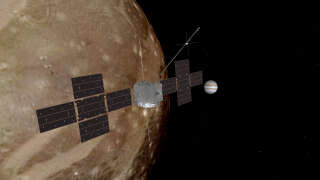SPACE – The year 2024 will be marked by the return of astronauts to the Moon. After the success of the Artemis I mission in 2022, NASA is preparing for the first manned mission to the Moon with Artemis II… 50 years after the Apollo program. The natural satellite is the subject of much desire and several space missions were launched there in 2023 and are due to continue next year.
But our Moon is not the only one to excite space missions. At the same time, other moons arouse the curiosity of scientists. As you can see in the video at the top of the articlethese are located nearly 630 million kilometers from Earth, revolve around Jupiter and could support life.
The race to the Moon
On the one hand, the United States, the only nation to have set foot on the Moon and which hopes to repeat this feat by 2025 with its Artemis program. But returning to the Moon is only the first step. The Americans then hope to create a lunar base in orbit around the Moon to return there regularly, and not only. This base would then become a crossing point before going to Mars.
On the other hand, China, a newcomer on the scene of lunar conquest. If for the moment it has only succeeded in sending probes, it remains the only nation to have explored the hidden side of the satellite. Its goal is for its first taikonauts to set foot on the Moon by 2030. Just like the Americans, the Chinese hope to one day create a lunar base, but they want to build one directly on the Moon.

ISRO
Indian probe Chandrayaan-3 on the surface of the Moon
While waiting to achieve this, China is also using the Moon to develop its space program as a whole. “The Chinese program is very focused on technology. The objective is to learn how to develop very advanced technologies specific to planetary exploration”explains Francis Rocard, astrophysicist and head of solar system exploration programs at CNES. “India also has the same approach but less ambitious”, he explains to HuffPost.

Testing ground for new space powers
The summer of 2023 was also marked by two lunar events. First of all, India has confirmed its position as a space power. In mid-July, it sent its probe, Chandrayaan-3, towards the Earth’s satellite. And on August 23, India achieved the feat and joined the very exclusive club of major space powers having successfully carried out a moon landing. Only Russia (at the time of the USSR), the United States and China had succeeded until then.
At the same time, there was the return of Russia with the restart of its Luna program. At the beginning of August, it sent its Luna-25 probe, a first in more than 50 years. Just like the Indians with Chandrayaan-3, Russia is seeking to land at the South Pole, because scientists have identified icy water there, but this water could become essential for future space missions. Unfortunately, Luna-25 ended up crashing on the surface of the Moon ten days later.
Other countries use or aim to use the Moon as a testing ground. Among them are Japan and the United Arab Emirates. “There is a combination of circumstances between the American approach and other countries which see it as a way of learning about deep space by using missions to the Moon,” underlines Francis Rocard.

Extraterrestrial life near Jupiter?

ESA
Illustration of the Juice probe flying over Ganymede, one of Jupiter’s moons.
If our Moon has nothing to do with those of Jupiter, the latter remain no less fascinating for scientists. “At the time of the Galileo missions, we discovered that under the icy crust of these different moons, there are oceans of salt water,” remembers Gabriel Tobi, CNRS research director at the Planetology and Geosciences Laboratory. “And when we think of the ocean, we think of potentially habitable places.”
This is why the European Space Agency (ESA) sent its JUICE probe last April. This must fly over the three Galilean moons, focusing in particular on Ganymede, the only one to have a magnetic field which protects against Jupiter’s radiation.
But the Europeans will not be alone in the Jovian system, they will be joined by the Americans who must also send a probe. NASA is due to launch Europa Clipper in October 2024. As its name suggests, it will focus its mission on the moon called Europa. But JUICE and Europa Clipper have the same objective: to determine the habitability of Jupiter’s moons, that is to say whether life is possible there or not.

Although this is not the case for our own Moon, perhaps one day we will find life near Jupiter, hundreds of millions of kilometers away. In any case, the Moons are more than ever gateways to the conquest of space: to new forms of life, or to infinite space.
Also see on HuffPost :

